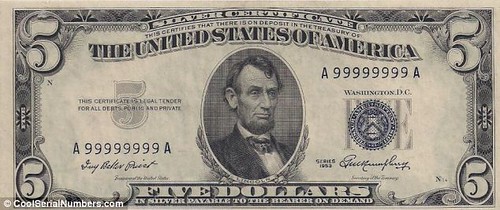
PREV ARTICLE
NEXT ARTICLE
FULL ISSUE
PREV FULL ISSUE
ARTICLE DISCUSSES MARKET FOR FANCY SERIAL NUMBERS
The cynic in me could say something about the lengths journalists will go to these days to dredge up copy to fill their vast internet venues, but I think this Daily Mail article based on a commercial website is kind of interesting. It discusses the market for fancy serial numbers of U.S. notes.
-Editor

The next time you're holding a dollar bill, it might be worth looking further than the big number one - you could get more bang from your buck than you expected. Ordinary low denomination bills are raking in thousands of dollars in an online trend that is centred on the eight-digit serial number which appears on each U.S. banknote. 'Unusual' bills are being bought, sold and hunted on the website CoolSerialNumbers.com, with low serial numbers, from 00000001 to 00000100, being particularly sought after, a $1 bill with the serial number 00000002 going for $2,500. The U.S.-based site lists all the different notes that collectors are looking out for and allows serial number fans to get in touch with one another. There are categories such as 'solids' (where the digits repeat eight times), 'ladders' (12345678), 'radars' (01133110 - where the number reads the same left-to-right as right-to-left) and 'repeaters' (20012001 - the second half is the same as the first half). Then there are 'radar repeaters' (12211221), 'super radars' (20000002 - all the internal digits are the same) and 'super repeaters' (where the first two digits are repeated four times, such as 63636363). Dave Undis, the a Nashville musician and currency collector who runs the site, is happy to include some criteria that might go unnoticed to the untrained eye - such as a 'pi note' with the number 31415927. A $5 bill with the number 33333333 is currently up for sale for $13,000, while a set of nine $20 bills running from 00000010 through to 00000090 can be bought for $1,800. Collectors have long been interested in rare and flawed money - and not just in the U.S. In September last year, the Bank of England auctioned £5, £10, £20 and £50 notes with unusual serial numbers - such as those coming at the beginning or the end of a run, often characterised by the prefix A01. To read the complete article, see: Is your dollar bill worth thousands? The bizarre trend for collecting cash with ‘interesting’ serial codes (www.dailymail.co.uk/news/article-2423315/Dollar-Serial-numbers-make-banknotes-worth-thousands-online-trend.html)
On the way home from my son's basketball game tonight, I was looking through some news stories on my phone (my wife was driving). And I came across a familiar-looking story, this one from the Boston Globe. Dated a couple days before the Daily Mail piece, the headline was "For serial-number hunters, $100 isn’t just $100". The article focused on how some of the soon-to-be-released $100 bills could have fancy serial numbers and be worth more than face value. The article referred extensively to the same web site, coolserialnumbers.com.
-Editor
To read the complete article, see: For serial-number hunters, $100 isn’t just $100 (www.boston.com/2013/09/15/dollars/C0qw9KcJvAmWwGyVWqREOJ/singlepage.html)
THE BOOK BAZARREWayne Homren, Editor The Numismatic Bibliomania Society is a non-profit organization promoting numismatic literature. See our web site at coinbooks.org. To submit items for publication in The E-Sylum, write to the Editor at this address: whomren@gmail.com To subscribe go to: https://my.binhost.com/lists/listinfo/esylum All Rights Reserved. NBS Home Page Contact the NBS webmaster 
|